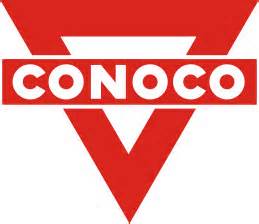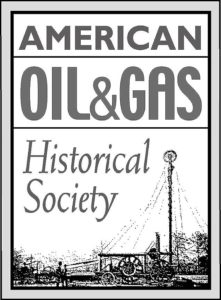Museums in Bartlesville and Ponca City have preserved Oklahoma exploration and production history. One still does.
As part of Oklahoma statehood centennial celebrations in 2007, ConocoPhillips opened two petroleum museums dedicated to preserving the state’s exploration and production history. In April 2025, the spun-off downstream company Phillips 66 closed the museum in Bartlesville, citing a decline in visitors after an earlier decision to require appointment-only visits.
Often staffed with volunteers like many other Oklahoma oil museums, the Conoco Museum in Ponca City and Phillips Petroleum Company museum in Bartlesville have featured interactive exhibits, oilfield artifacts, and community events along with K-12 education programs about the industry’s energy future.
Created in 2002 through the merger of Conoco and the Phillips Petroleum, ConocoPhillips reportedly spent $5 million on each museum for the 2007 centennial openings. In 2012, Phillips 66 became an independent company when ConocoPhillips spun off its refining, midstream and marketing businesses. Phillips 66 markets across the United States under the Phillips, Conoco and Unocal brands.
The permanent closure of the Bartlesville Phillips Petroleum Company Museum (with some artifacts moving to the Frank Phillip Woolaroc Ranch) has left an uncertain future for the statehood centennial’s Conoco Museum, now requiring appointments to visit.
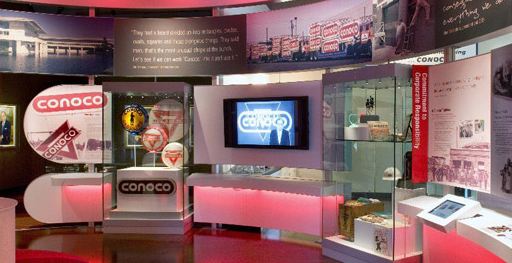
The Conoco Museum in Ponca City, Oklahoma, tells the story of a company that began as a kerosene distributor serving 19th century pioneers. Photo by Bruce Wells.
“These museums reaffirm our Oklahoma roots,” proclaimed ConocoPhillips Chairman and CEO Jim Mulva on May 12, 2007, five years after the merging of Conoco and Phillips Petroleum, creating the third-largest U.S. oil company. He said ConocoPhillips opened the state-of-the-art museums as “gifts to the people of Oklahoma, visitors to the state, and our employee and retiree populations around the world.”
Ponca City’s Conoco Museum includes five areas exhibiting the evolution of the company’s business identity, marketing – and onshore and offshore technologies. Oklahoma’s first oil wells were drilled near oil seeps when the state was still Indian Territory.
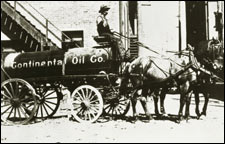
Conoco was founded in 1875 as Continental Oil Company, delivering kerosene to retail stores in Ogden, Utah.
One exhibit recreates a 1950s typical petroleum industry R&D laboratory; another depicts an outdoor scene of a “doodlebugger” at work using refraction seismic equipment; a third explains the offshore technologies behind the world’s first tension-leg platform.
The Conoco Museum exhibits in Ponca City offer insights into the major oil company’s development from a small kerosene distributor serving 19th century pioneer America into a diversified global energy company. Conoco — founded as Continental Oil Company in Utah — merged with Oklahoma’s Marland Oil Company in 1929.
Continental Oil Company
Conoco began in the 1870s when Isaac Elder Blake — a young speculator in Pennsylvania and West Virginia oilfields — moved to the Utah Territory. Once there, he learned residents of Ogden paid $5 a gallon for the lamp fuel kerosene, which was refined hundreds of miles away in Florence, Colorado, and hauled in barrels by bull teams to Ogden.
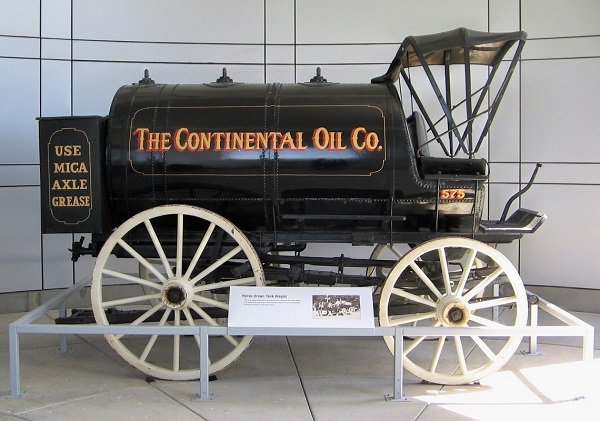
A circa 1880s Continental Oil Company horse-drawn tank wagon welcomes visitors to the Conoco Museum in Ponca City, Oklahoma. Phillips Petroleum, once headquartered 70 miles to the east in Bartlesville, merged with Conoco in 2002. Photo by Bruce Wells.
In 1875, Blake stared a venture that would purchase bulk kerosene in the cheaper eastern market, then ship it by rail to Utah Territory. In Ogden, the oil was put into manageable containers and delivered to grocery stores, which could dispense it to customers by the gallon, profiting accordingly.
The Continental Oil and Transportation Company purchased two railroad tank cars, the first such cars to be used west of the Missouri River (learn about early designs in Densmore Brothers invent First Oil Tank Car). By the late 1920s, the Utah company was adding gas service stations — and attracting the attention of a rapidly growing Oklahoma venture.
After discovering several prolific Oklahoma oilfields, Marland Oil Company acquired Continental Oil and Transportation on April 30, 1929, and established a network of service stations in 30 states.
The Marland Mansion
Future Oklahoma Governor Ernest W. Marland had founded Marland Oil in 1921. Headquartered in Ponca City, the new company retained the name of Continental Oil, but adopted the well-known Marland red triangle trademark, replacing the “Marland Oils” text with “Conoco.”
Born in Pittsburgh, Pennsylvania, in 1874, Marland’s interest in geology led him to the oil exploration industry, where he made his first fortune in the oilfields of West Virginia, “only to lose it all in the panic of 1907,” according to the Marland Estate in Ponca City.
The historic site has noted that in 1908, Marland came to Oklahoma, “with not much more than belief in himself and a letter of credit. Mr. and Mrs. Marland made their home at the Arcade Hotel, and E.W. set out to explore for oil.”

Phillips Petroleum Company opened its iconic Tudor cottage-style gas stations in the late 1920s and 1930s, beginning with the first Phillips 66 service station (left) on November 19, 1927, at 805 E. Central Street in Wichita, Kansas, in 2022 home to a popular auto upholstery shop. Photos courtesy Phillips Petroleum Company and Google Maps.
After finding renewed success in Oklahoma oilfields and becoming Oklahoma’s tenth governor in 1934, Marland died of a heart ailment in 1941. His combined Marland Oil and Continental — Conoco — would merge with Phillips Petroleum Company, which had incorporated in 1917.
Phillips Brothers
Phillips Petroleum, once headquartered in Bartlesville, 70 miles east of Ponca City, merged with Conoco in 2002 to become ConocoPhillips. Phillips had been founded during the early months of World War I, after the price of oil climbed above $1 per barrel.
The Phillips Petroleum Company Museum told the story of the company’s founders — brothers Frank and L.E. (Lee Eldas) Phillips, who began their quest for oil in 1903, after hearing of vast oil deposits in Oklahoma.
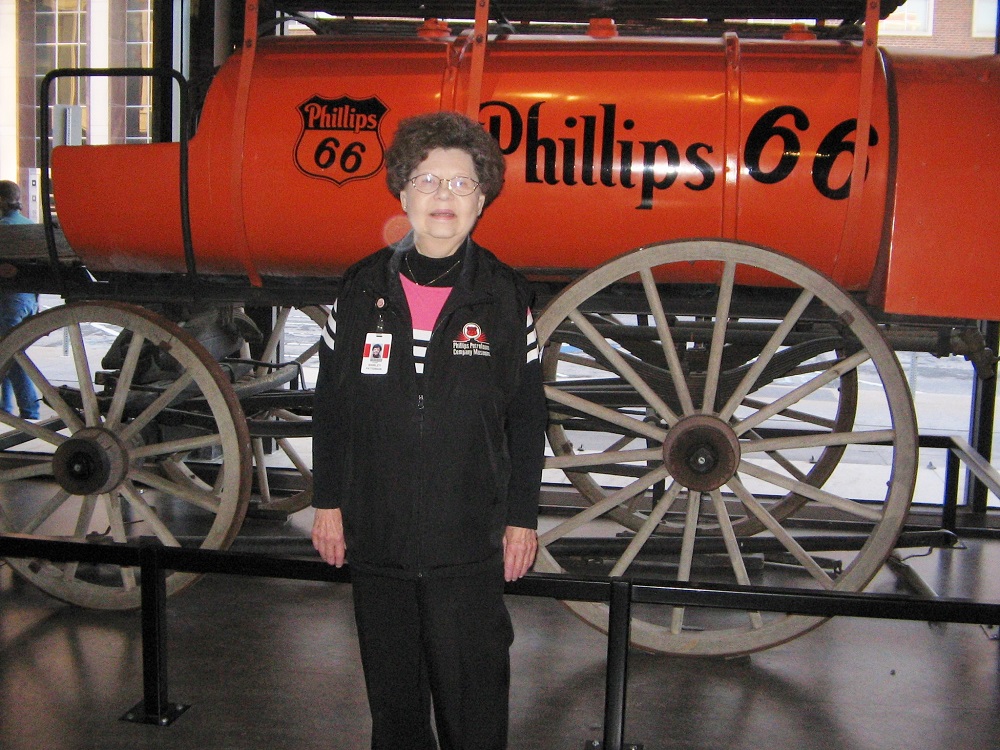
As a docent at the Phillips Petroleum Company Museum in 2012, Shirley Patterson provided visitors rare insights about the company she joined as a secretary in 1952 — and worked for every president except for the first, founder Frank Phillips. Photo by Bruce Wells.
In 1905, the Phillips brothers hit the first of 81 wells in a row without a single dry hole. Twelve years later, they founded Phillips Petroleum Company, headquartered in Bartlesville. Frank Phillips served as president of the company until 1938.
In June 1917, the brothers consolidated their Anchor Oil & Gas Company and Lewcinda Oil Company holdings into the new company, which began operating with assets of $3 million, 27 employees, and oil and natural gas leases throughout Oklahoma and Kansas.
Phillips 66 Brand
After a decade as an exploration and production company, Phillips Petroleum entered the highly competitive business of refining and retail gasoline distribution. In 1927, the company introduced a new line of gasoline – “Phillips 66″ – at its first service station, which opened in Wichita, Kansas.
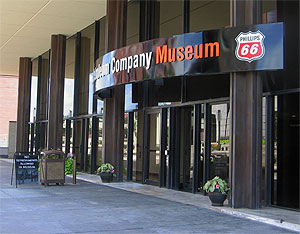
Bartlesville’s extensive petroleum history was exhibited at the Phillips Petroleum Company Museum until 2025. Photo by Bruce Wells.
The gasoline is named “Phillips 66″ after it propels company officials down U.S. Highway 66 at 66 mph in route to a meeting at their Bartlesville headquarters. The company also has drilled among the deepest and farthest offshore wells.
Further, Phillips Petroleum chemists initially researching gasoline additives developed Marlex, a revolutionary polypropylene plastic (learn more in Wham-O and Petroleum Product Hoopla).
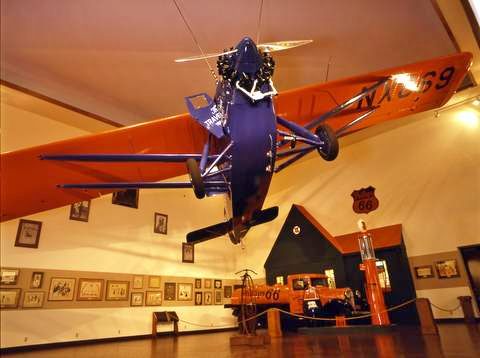
Bartlesville is home to Frank Phillips’ Woolaroc Ranch – which includes oil exhibits and the plane that won a 1927 air race across the Pacific.
Removed after museum’s the closing in 2025, Phillips Petroleum Company Museum exhibits featured the company’s heritage in distinct areas: A Pioneering Attitude — How Phillips Petroleum transformed basic oil and natural gas resources into many patented products. Growing Strong — The evolution of Phillips Petroleum and how the company survived an intense series of corporate battles. One Big Family — An exhibit describing how Phillips became known for promoting the well-being of its employees.
Bucking the Odds — What it was like in the rough and rowdy days of the Burbank oilfield and petroleum boom towns. Energy Provider — From refined petroleum fuels to super-cooled natural gas, delivering energy to consumers. Taking to the Skies — The Phillips produced its aviation fuels well before automotive fuel. Its high-octane Avgas helped power Allied aircraft to victory in World War II. Selling 66 — From street corners to sports stadiums, the Phillips 66 brand seen everywhere and various marketing campaigns.
Phillips Petroleum also left its mark on the aviation industry by designing the refueling trucks and developing Nu-Aviation Gasoline, which powered the first sponsored “Race for cash” flight between the United States and Hawaii (see Flight of the Woolaroc).
__________________________
Recommended Reading: Conoco: 125 Years of Energy (2000); Phillips, The First 66 Years
(1983); Oil in Oklahoma
(1976). Your Amazon purchase benefits the American Oil & Gas Historical Society. As an Amazon Associate, AOGHS earns a commission from qualifying purchases.
__________________________
The American Oil & Gas Historical Society (AOGHS) preserves U.S. petroleum history. Please become an AOGHS annual supporter and help maintain this energy education website and expand historical research. Contact bawells@aoghs.org. © 2025 Bruce A. Wells. All rights reserved.
Citation Information – Article Title: “ConocoPhillips Petroleum Museums.” Authors: B.A. Wells and K.L. Wells. Website Name: American Oil & Gas Historical Society. URL: https://aoghs.org/energy-education-resources/conocophillips-petroleum-museums. Last Updated: September 18, 2025. Original Published Date: May 12. 2008.

